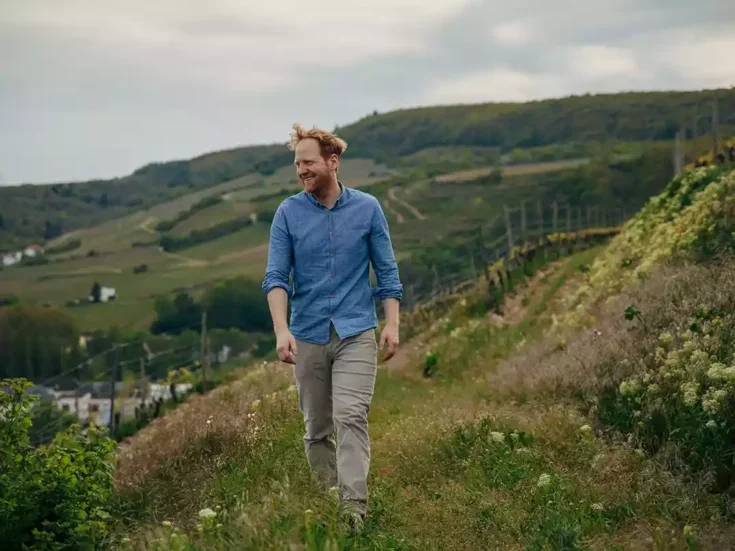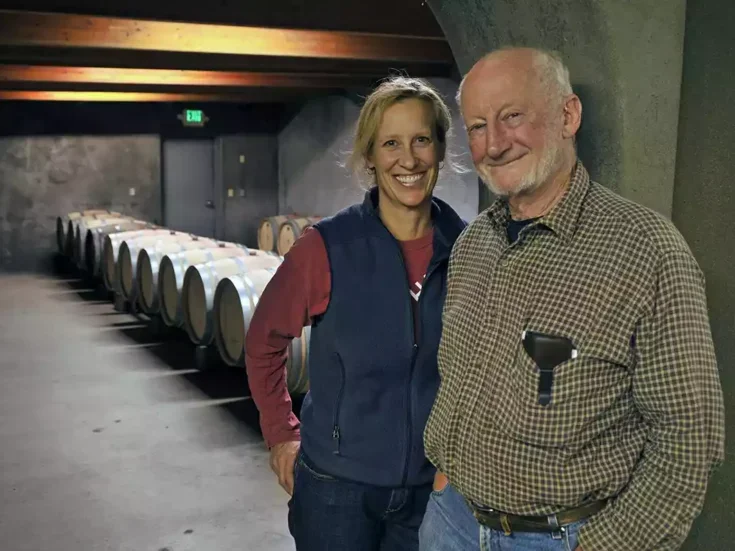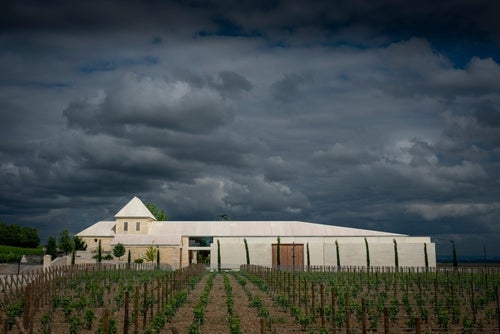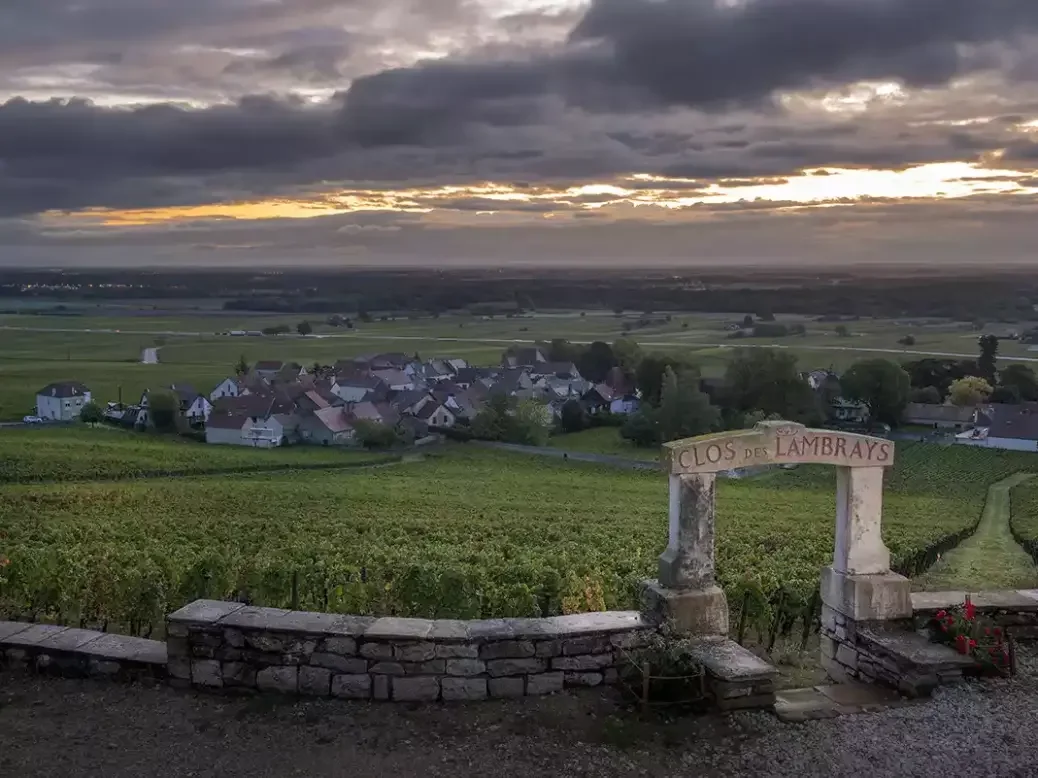
An awe-inspiring, century-spanning tasting at the domaine made a compelling case for Clos des Lambrays as one of the five top grands crus of the Côte d’Or. Neil Beckett reports.
Burgundy is history. No French wine region is more steeped in it. But even there—in the dukedom that, for much of the later Middle Ages, was well in advance of the kingdom of France, as the land of Bernard of Clairvaux and Cîteaux, of Philip the Bold and Philip the Good, Claus Sluter and Rogier van der Weyden, the Hospices de Beaune and de Nuits—perhaps no domaine, no vineyard has a longer and stronger historical thread running through it, for more than seven and a half centuries, than Clos des Lambrays. The thread may occasionally have worn thin, and for long periods disappeared entirely into the fading Burgundian tapestry, which has itself changed, often dramatically, over that time. But all those changes merely serve to highlight the constancy of the essential features of this very special climat as expressed through its wines: its clear identity, its complete integrity, its extraordinary longevity, and its exhilarating quality.
At a Century of Clos des Lambrays dinner held on November 16, 2023, at the domaine, its current custodian and translator, régisseur Jacques Devauges, expressed, with characteristic humility and sincerity, his conviction that Clos des Lambrays is one of the five or six most outstanding grands crus in the Côte d’Or. (The others, north to south, are Chambertin-Clos de Bèze, Musigny, La Romanée, Romanée-Conti, and La Tâche.) The wines he shared (13, including a barrel sample of the 2023), from five decades within a 100-year span, from 1923 to 2022/23, made his claim completely convincing to me and, I imagine, to many or most of the other ten guests (one private collector, as well as members of the press and trade, including representatives of US and UK agents Vineyard Brands and Flint Wines).
Fragmentation and resurrection
In a 2012 WFW article reviewing the 1999–2009 Clos des Lambrays, the late Clive Coates MW, who must have tasted as much great Burgundy as anybody, praised the 1945, 1947, 1948, and 1949 vintages he had shared with Alexis Lichine in the late 1970s and early 1980s as “some of the finest Burgundies I have ever drunk” (see WFW 36, pp.60–63). With his customary detail in historical matters, Clive relates there the long and fascinating story of the vineyard, which he traces back to 1258, when a document in the archives at Cîteaux (which had been given the seigneurie of the village of Morey in 1120) mentions the Frères Lambrays and their wines. I encourage readers to refer back to Clive’s account, especially since limitations of space will restrict me here to a summary of the key periods and personalities, especially those highlighted by Jacques himself during our dinner.
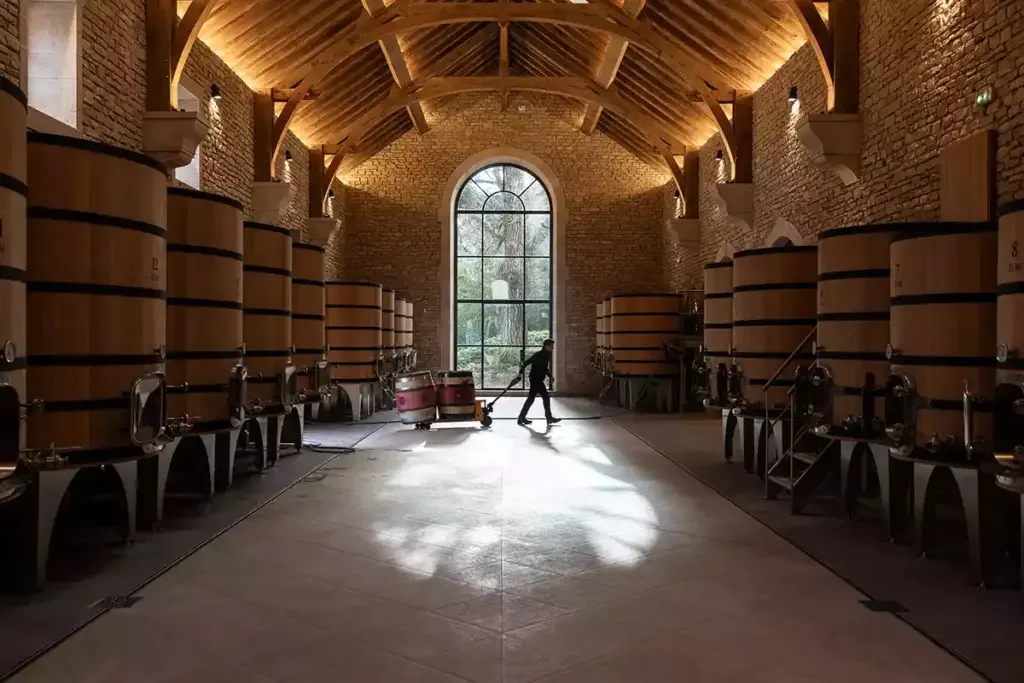
During the French Revolution, Clos des Lambrays, along with all other ecclesiastical property, was sequestered by the state and sold off piecemeal in 1791. Nuits-St-Georges merchant Louis Joly began acquiring parcels of the vineyard in the early 1830s; by 1855 he owned 7ha (17 acres), which seems to have been the full extent of the vineyard then. In 1865, he sold it to Albert Sébastien Rodier, director of another Nuits-St-Georges négociant, Maison Henri de Bahèzre, who expanded it to its current size of 8.7ha (21.5 acres). After World War I, the business struggled under Rodier’s two grandsons, another Albert and Camille, who sold it to the Cosson family. Monsieur Cosson was a wealthy Parisian banker, but his wife, Renée, was a famous sculptress and rich in her own right. She was also Albert Rodier’s mistress, and she bought out the rest of the Cosson family, taking over as owner of Clos des Lambrays in 1938 and often residing in its château.
Already on the scene for 50 years was the unsung hero of these difficult decades, not mentioned in Clive’s account but given proper recognition by Jacques at our dinner—régisseur Etienne Amiot, who made all of the older wines we tasted then. His first harvest was in 1888, when he started as a porter in the vineyard at the age of 13. He missed a few vintages due to national service and World War I, but he saw in as many as 51 harvests, his last in 1947.
Amiot had challenges aplenty. According to Clive, “Mme Cosson was as obdurate as she was passionate about her vineyard, and as the old pre-phylloxera vines died, she refused to replace them. She also failed to compost the vineyard. Yields fell to 10hl/ha.” She also refused to allow chaptalization and insisted on long cuvaisons and on keeping the wine in cask until it was sold; it seems that some of the 1973 vintage was still unbottled in 1979. (Jacques says that at least some of the wine was bottled at the domaine as early as 1907, and possibly before then.)
None of Renée Cosson’s children wanted to assume responsibility for the property, which she tried to sell unsuccessfully in the 1970s. She died in 1977, and in 1979 her heirs finally sold the château and the vineyard, for a price rumored to be as low as FF10 million, to a consortium headed by Fabien Saier and his son Louis, owners of another Burgundy domaine. In 1980, they appointed as régisseur Thierry Brouin, a skillful winemaker who was in the role for 38 vintages. (See Jon Wyand’s portrait of Thierry Brouin, WFW 58, pp.118–19.) They also applied for promotion to grand cru—a status that the Rodiers and Cossons had not sought when the classification was being established in the 1930s. Asking why not, Clive speculated: “No one is quite sure. As with La Grande Rue, the answer seems to be sheer inertia, together with a worry that they would pay more tax.” As he reasoned, there was always a strong prima facie case for grand cru status. A proper clos, surrounded by walls, on the north side of grand cru Clos de Tart but extending higher up the slope, it sits near grands crus Clos St-Denis and Clos de la Roche: “All are at the same level of altitude, have the same sort of protection from the prevailing westerly wind, share the same aspect to the east, and are comprised of more or less the same soil structure: a limestone marl.” Promotion of Clos des Lambrays was duly secured on April 27, 1981 (that of La Grande Rue in Vosne-Romanée in 1990). This might be the place to note that although it is often regarded as a monopole grand cru, it is not quite that, strictly speaking. A small parcel, just under one ouvrée (4.28 ares [0.1 acre]) in size, at the bottom, belongs to Jean Taupenot-Merme and his wife, who live below; they used it as a vegetable garden until 1974, when they planted vines there, but they blend the fruit into one of their Morey-St-Denis premiers crus, as it produces no more than one barrel of wine. Jacques admits that it would certainly be nice to own the entirety of the vineyard, and he jokes that if ever the Taupenot-Mermes wanted to sell their parcel, they would know where to come knocking. But he adds that when Domaine des Lambrays already owns 99.6% of the vineyard, the remaining 0.4% would not make any appreciable difference to the final wine.
The Saier consortium made it possible for Brouin to replant some 2.44ha (6 acres) in the northern part of the vineyard, and to fill in the gaps elsewhere. The fruit from the young vines went into a new second wine, a Morey-St-Denis premier cru called Les Loups (the name for residents of the village). The château and park were restored, and the cellars refurbished. But having bought out their two partners and become the sole owners by 1988, the Saiers found their investments difficult to recoup, and they put the domaine up for sale—“ironically,” as Clive wryly remarked, “just when the wine was starting to reveal its potential once more.”
It was bought in 1996 by German advertising mogul Günter Freund and his son Hans-Joachim, who purchased the largest grand cru parcel under single ownership for a sum amounting to $9 million. They modernized the living quarters and spent time there as a family. And the quality of the wines continued to improve: “Vintages since 1996, and increasingly since 2000,” Clive concluded, “have certainly been equal to the very best that the top vineyards of Morey-St-Denis can offer.”
Conversion and revelation
Bernard Arnault, founder, chairman, and president of LVMH, acquired Clos des Lambrays from the Freund family in 2014. The domaine was briefly under the management of Boris Champy (who now has his own domaine in Nantoux, on the Hautes-Côtes de Beaune), before Jacques Devauges was invited to move from neighboring Clos de Tart to take over as régisseur in March 2019.
Over the next three years, the domaine was converted to organic farming (2019), then biodynamic (2020); 2022 was the first vintage to be certified organic. A new winery was built—airy and light, of an almost Cistercian simplicity, inspired by the estate’s monastic origins—the magnificent cedar planted in 1637 visible through the arched window overlooking the park. If the aesthetic is old, the equipment is cutting-edge, including temperature-controlled, completely sealable wooden fermentation vats, designed by Jacques himself and made by François Frères, as well as a glass lift that allows everything to be moved by gravity without any need for pumping. The barrel cellar has been expanded and refurbished, and a massive slab of entrochal limestone discovered during the excavations made into a magnificent tasting table at Jacques’s suggestion.
While Jacques attributes roughly 20% of the final quality of the wine to its treatment in the winery, 80% of the quality, and 100% of the potential, still comes from the vineyard. During his first three years, he deepened his knowledge of the different plots within the clos, identifying and separately vinifying 11 plots rather than eight, as previously. Although the bedrock varies across the vineyard, the soil is generally a deep, red-brown marl, rich in iron, with more clay lower down the slope, where the plots contribute power and structure, while the higher plots, where there is even some sand, lend elegance, finesse, and fragrance.
Some 70% of the vines were planted between 1935 and 1998, and from the first post-phylloxera plantings onward, they have been high-quality Pinot Fin. The rows were oriented north–south rather than east–west, running across rather than up and down the slope, as is more usual. Initially, this was to reduce the risk of erosion. But an additional benefit in our climate-change era (and one for which Jacques is ever more grateful) is that in hot, dry vintages, the fruit is more protected from the strong midday sun, while in cooler, later years (like 2008, 2013, or 2021), it gets the sun twice a day, early and late, which helps it ripen.
Jacques believes that the biodynamic practices are already resulting in greater energy, purity, and precision in the wines. And he thinks that when two of his three defining qualities of Clos des Lambrays wines—a caressing delicacy and grace—are almost equally evident in back-to-back vintages as different as 2020 and 2021, this is striking proof of the expressive power of its special terroir.
Timeless terroir wonders
Equally convincing and moving testimony was provided by all eight of our older wines, which were also produced in very different vintages, and in circumstances dramatically less propitious than those pertaining today. They also reveal in the most thrilling way the third of Jacques’s defining qualities—the ability to age spectacularly well.
Jacques is convinced that the 100% whole-bunch fermentation for all the older wines will have helped to extend the longevity naturally bestowed by the vineyard. (By contrast, he has found that some completely destemmed, fully mature wines made in the 1970s, ’80s, and ’90s—even those from very famous and recherché producers—have aged less well.) Above all, however, Jacques believes that the extraordinary longevity of Clos des Lambrays wines is due not merely to acidity or tannins, or even to perfect balance, but primarily to the inscrutable but nevertheless tangible effects of the totality of the terroir.
All of the older wines we tasted were so much more than curiosities, though they were certainly rarities; and so much more than remarkable survivors, though they were certainly that, too, not least for having been hidden in the cellars at the domaine during World War II, behind false walls blackened with charcoal to make them look as old as the rest. Nobody at the dinner needed to make any allowances, any concessions, any excuses for the wines’ venerable age; their harmony, integrity, and personality were more or less perfectly preserved; refined through “lengths and breadths of time,” without any of the ambiguity or blurring of form or meaning suffered by the earl and countess in Philip Larkin’s poem “An Arundel Tomb.” Instead, everybody marveled at how such glorious wines could be produced in such difficult circumstances, so different from those today, and reveled in “their final blazon.” “Incredible” is a much overused word, but it was often on our lips that evening, and it is equally hard now to find a more apt word to describe the sense of awe left by any one of these wonderful wines.
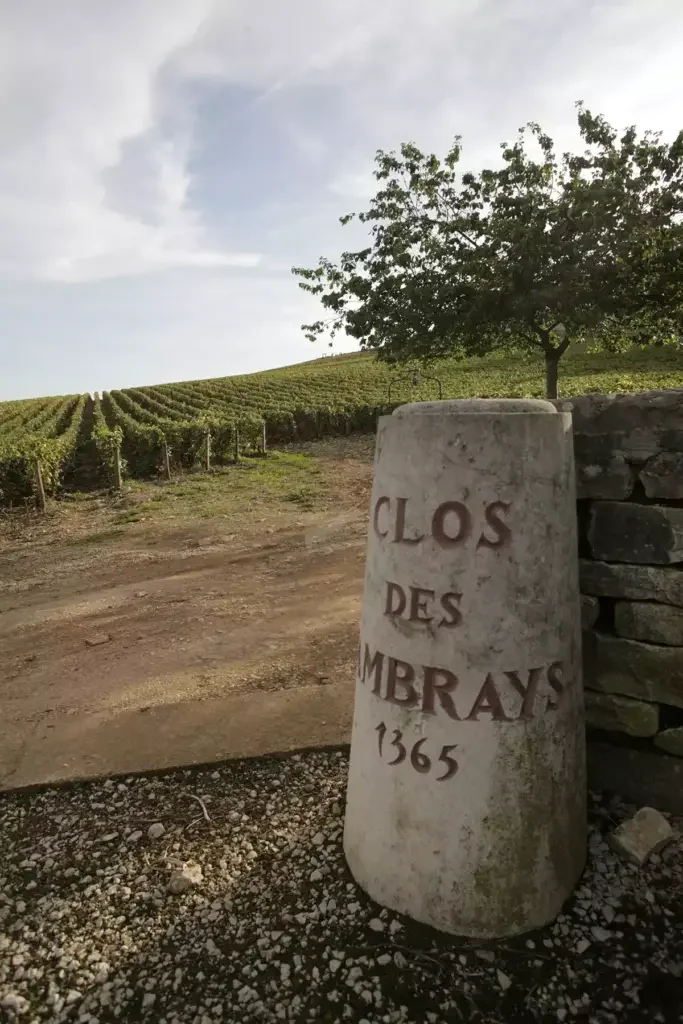
All of the older wines apart from the 1938 were reconditioned in 2018, without any exposure to oxygen, in a special machine made and operated by Michael Paetzold. The bottles were all brought up from the cellar and stood up for seven days before the tasting, opened four hours before the dinner, and poured straight into guests’ glasses.
With a confident disregard for any legal niceties, Renée Cosson dignified her wines with the identity of “Grand Cru Classé.” Jacques did not honor that tradition, but he did still exercise a little avant la lettre poetic license in referring to all of the older wines in the dinner program as “Grand Cru.” The deeper reality behind that was also captured by Camille Rodier’s classification as Tête de Cuvée, which Jasper Morris MW was willing to endorse in Inside Burgundy after a 20-vintage vertical back to 1918: “Clos des Lambrays really can stand up with the grandest of grands crus.”
Jacques’s comments on each wine in the dinner program are reproduced almost verbatim at the beginning of each of the tasting notes below, together with any other information shared by him round the table. The dinner dishes, brilliantly conceived and executed by chef Maxime Besson, and the pairings, were as follows: blue lobster, Jerusalem artichoke, Petrossian Fleur de Caviar (2021, 2020); farm chicken terrine, blackcurrant mustard, Burgundy truffle (1947, 1946, 1942); veal fillet, parsnip, white truffle (1938, 1937, 1934); cheese (1926, 1923).
Tasting
November 16, 2023
2022 Clos des Lambrays Grand Cru
Fourth vintage of organic viticulture (ECOCERT certified). Made in the new winery: in wooden tanks, 100% gravity, and with a parcellaire approach. Yields: 30hl/ha. Harvest: September 1–6. 13.7% ABV.
This was a proportionate réunion of all the parcels, as Jacques did not expect to bottle the final wine until mid-April 2024, after 19 months in barrel, 20% new. Medium-deep ruby, good intensity and luminosity. A beguiling first nose: balance, poise, gentle intensity, and exhilarating fruit purity, with black raspberry, light licorice, and the first hints of floral, sweet herbal, and spice notes. Very gentle, graceful, silken entry—what Jacques aptly describes as a “caress”—with great layered density as it gradually expands in the mouth but also superb refinement of very fine-grain tannin, a gentle squeeze, finely supportive, succulent throughout, with a fruit ripeness that comes across almost as a sucrosity on the mid-palate, and a gentle glowing warmth on the finish. This was already purring with promise. Retasted at Jacques’s official launch of the wine at Claridge’s Hotel in London on March 12, 2024, this was still beautifully transparent but even more expressive and vivid, with more of the aromatic nuances starting to show, which revealed more clearly how harmoniously and seamlessly they weave together. There are no negative telltale signs of the 80% whole-bunch fermentation, the stems as invisible per se as Jacques always hoped. The depth of the layering and the grandeur of the scale were also clearer four months on, leaving no doubt that it has the structure to age for decades, but as the tannins gradually melt and soften rather than tighten and the final impression is of great fragrant persistence, there is equally no doubt that the aging will be graceful and all the defining characteristics crystal-clear at full maturity. | 98–99
2021 Clos des Lambrays Grand Cru
Frost on April 6–8. Cool and wet summer. Sunny September. Yields: 15hl/ha. 13.6% ABV (chaptalized up from 13.1/13.2%).
A slightly lighter hue than the 2022 or the 2019, but still a good, clear mid-ruby. A little more aromatic reserve than the 2022, with alluring dark-fruit scents, more cherry than raspberry, but with the same perfect poise. (Jacques described it as shy and tight but explained that it had shown good perfume and sweetness during élevage.) A cashmere softness as it reaches the palate, which is ample and supple, with perfect ripeness despite the challenges of the growing season, but also a harmoniously integrated acidity to ensure freshness and a core of very precise fruit. | 96–97
2020 Clos des Lambrays Grand Cru
Historically hot and dry year (+20% sunshine and -35% rainfall). First vintage of biodynamic viticulture. Yields: 15hl/ha. Harvest: August 20–26 (previous earliest record: August 23–September 2, 2003). 13.7% ABV.
Deepest ruby, almost opaque, only the faintest glimmer. Very dark-fruited and intense on the nose, back to black raspberry rather than cherry, with an earthy licorice note, but this is still a very composed and elegant scent, with no disconcerting, distorting warmth. (Jacques was very pleased and relieved that the alcohol level was below 14%, which was rare among top grands and premiers crus in this hot vintage.) Dense, rich, and multilayered on the palate, with plenty of supportive structure—this is the most abundantly tannic of the four younger vintages—but the quality of those tannins (a word that wrongs them) is superlative: highly refined and supremely silky, with spectacular, lingering length. As monumental and as smooth as the most polished marble statue (much more Venus than Mars). | 97–98
2019 Clos des Lambrays Grand Cru
First vintage of organic viticulture and the first vintage with a parcellaire approach. Yields: 15hl/ha (a combination of the vintage effect and the conversion to organic viticulture). Harvest: September 13–17. 80% whole-bunch. 13.7% ABV.
Although this vintage appears here in chronological order, Jacques chose to show this wine first—and with good reason. It is clearly a historic vintage and a brilliant debut in terms of the new approach and the new winemaker, but the extremely low yields from the first organic vintage may be almost endearingly evident by comparison with the three subsequent vintages, which fully support Jacques’s belief that the benefits of the biodynamic approach are already becoming clearer and clearer. Medium-deep ruby. Aromatically, this is little more obviously “polished” than later vintages, a little drier and spicier in its 80% whole-bunch and oak influence. A lovely brightness to the acidity, in a vintage that can seem rather simply “sweet,” beautifully integrated and wrapped and not at all shrill, with a black raspberry and bramble character to the fruit. A slightly less fine grain to the tannin, and a shade drier and warmer on the finish, showing the wood a little more—but only relatively speaking. | 95–96
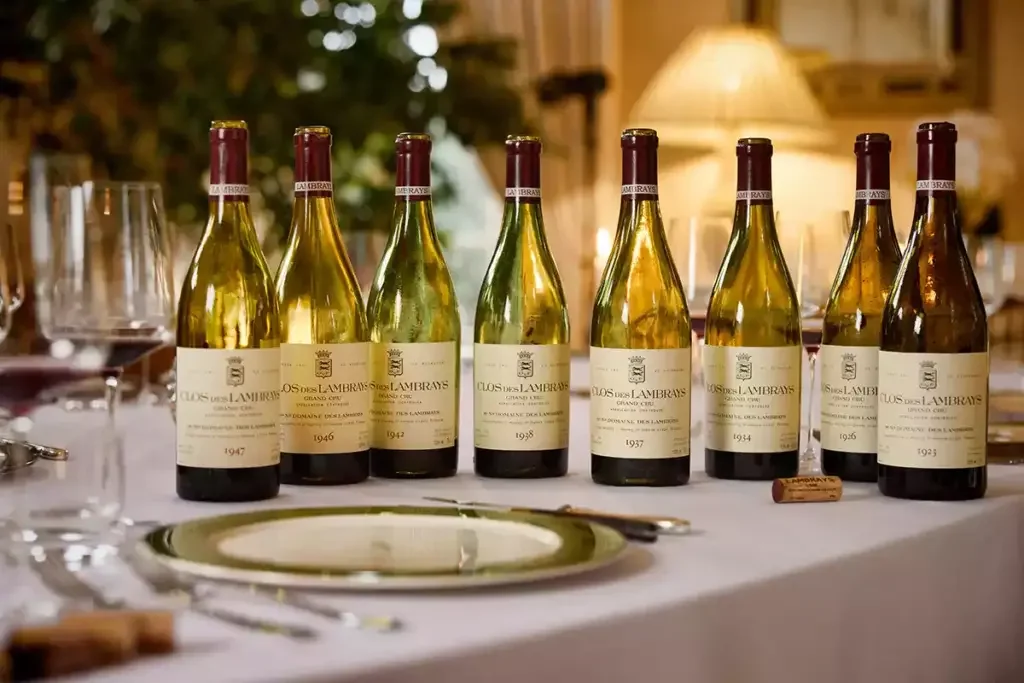
1947 Clos des Lambrays Grand Cru
Cosson era (with the help of Albert Rodier, the last vintage of régisseur Etienne Amiot). Considered a good vintage. One of the hottest vintages of the 20th century (with 1976 and 2003): 104˚F (40˚C) between July 20 and August 5. Harvest: September 15. Average yields.
A great leap back in time to a completely different era, starting with a vintage more than 70 years older than any of the younger wines. Still a beautiful, clear, mid-ruby. Arrestingly—almost brutally—intense on the nose, but not at all coarse and remarkably pure, with dried morel and smoky-bacon notes, not nearly as tertiary as that might sound, the mushroomy notes fading rather than strengthening with more time in the glass, seeming to get fresher and fresher rather than tiring. Dense, elegant, and silken on the palate, with extraordinary freshness for its age and vintage, and fabulous persistence. One would never imagine that this wine was more than 75 years old, and I would have been decades out if served the wine blind and asked to hazard a guess at its vintage. After a couple of hours in the glass, this was still going strong and holding up even better than the other two wines from the ’40s. | 98
1946 Clos des Lambrays Grand Cru
Cosson era (with the help of Albert Rodier and régisseur Etienne Amiot). Considered a poor vintage. Cold and rainy weather from August 5 to the end of September. Harvest: September 28. Small crop.
A deep ruby hue. Another quite superb scent, with gentle balsamic and black-olive notes, but still so fresh, so focused. Good layered density on the palate, with excellent, well-integrated freshness and fine-grain tannins making for a supportive structure. Great, lingering freshness and sweetness on the finish, betraying no hint of any of the difficulties of the growing season, and which Jacques also found “very seductive.” An against-all-odds beauty. | 97
1942 Clos des Lambrays Grand Cru
Cosson era (with the help of Albert Rodier and régisseur Etienne Amiot). Considered an acceptable vintage. Generally dry season, but not hot. Very serious supply problems (vineyard products, SO2, bottles…), and the wine was probably bottled quite some time after the end of World War II in 1945. Harvest: September 25. Average yields.
A less deep ruby than the two previous wines, but still in good heart for its age, with a little more evident sediment. An exquisite bouquet, well captured by Jacques as “végétal noble, dried herbs and tobacco, and old tea roses,” with, for me, a very fine, mint-toffee note (reminiscent of a 1917 Niepoort white Port generously shared by Dirk Niepoort several years ago). Again, far from fading over time, the fragrance actually seemed to freshen and improve. Lighter on the palate than the previous two wines, but completely captivating and enchanting in its delicacy and grace, with a beautifully fresh, gently cleansing finish. Jacques admitted that, if forced to choose among the three wines from the ’40s, this might be his favorite—a preference shared by several other tasters. | 98
1938 Clos des Lambrays Grand Cru
Cosson’s first vintage (with the help of Albert Rodier and régisseur Etienne Amiot). Considered a poor vintage. Cool and cloudy summer. Small crop, delay in wine sales due to World War II. Harvest: October 8.
While the other two vintages from the ’30s—the 1937 and 1934—have always been recognized as good or even great vintages, the 1938 has largely been “forgotten,” as Jacques put it. But for him it holds “a lot of emotion”—not only because it was the first of the Cosson era, but also because it is still such a delicious wine to drink, despite coming from such a tricky vintage. While it is clearly a fully mature wine, there is no decay, and when Jacques served it blind at a paulée-style event in London a few years ago, the closest guess as to its age was that it was 30 years old—when it was more than 50 years older than that. A pale to mid-ruby, with an even gradation toward the rim and a little sediment. Very savory and umami in scent, with more of the morel mushroom and lightly smoky bacon, but still very intense, still with a core and surrounding detail, nothing remotely fading or wispy. Equally remarkable depth on the palate, which was deeper and richer than either of the vintages from the ’20s, still layered and silken, with a reprise of the savory notes on the nose and slightly dry, cleansing tannins, but without any astringency. There is an autumnal feel to this, but the leaves are bright, dry, and intact, not at all damp, dank, or rotting; the blaze-of-glory splendor of a New England fall, as perfectly preserved as between the pages of a family bible. While the conditions in which this bottle was enjoyed could hardly have been more favorable, it was encouraging and exciting to see that another bottle (certainly of equally impeccable provenance and storage) that Jacques showed at a dinner at Hélène Darroze in The Connaught Hotel after the London launch of the 2022 on March 12, 2024, had traveled very well. Again alongside the 1937 on that occasion, too, it was the more expressive of the two initially, additional descriptors including quince and tea (from Jacques), cardamom and Moroccan leather (from me), and two very experienced and expert Burgundy buyers around the table preferred it to the ’37. | 97
1937 Clos des Lambrays Grand Cru
Rodier era (régisseur Etienne Amiot). Considered a good vintage. Bright, dry, and hot summer, into September, with well-timed rain on September 9. Harvest: September 23. Low to medium yield.
Clear, mid-ruby, still with a dullish luster. An amazing bouquet (all tasters agree): much fresher, more focused, more vital than the 1938; ethereal levity without any fuzzy volatility, complex but so perfectly seamless that it is difficult, and maybe even disrespectful or trivializing, to try to separate out any of the many threads in the fragrant tapestry. A spring-like, pea-shoot freshness and floral allure (not roseate; maybe more sweet pea?), with the faintest balsamic top notes the only hint as to its actual age. A correspondingly magnificent palate, a crimson silk mille-feuille, the harmony to match the intensity, perfect poise, and a fabulous, gentle flourish on the finish that purifies and thrills. Another bottle alongside the ’38 at the Hélène Darroze dinner in London in March had survived the trip equally well. While the ’38 did not fade in the glass, the ’37 blossomed over time, becoming fresher and more expressive, with a melting texture less silky than velvety. Jasper Morris found the most fitting word to describe both the 1937 and the 1923 vintages following his tasting of 20 vintages back to 1918: “transcendental” (Inside Burgundy). | 98
1934 Clos des Lambrays Grand Cru
Rodier era (régisseur Etienne Amiot). Considered an excellent vintage. Sunny and dry summer. Very hot, nearly at heatwave levels. Some rainfall in early September. Harvest: September 22. Abundant crop.
Astonishing clarity and intensity to the mid-ruby hue. Jacques admitted to finding this a little reticent on first sniff, but it continued to get fresher and fresher the longer it had in the glass. A fabulously ripe, sweet bouquet, with an almost vanilla-like richness and the cherry character that Thierry Brouin identified as a fruity hallmark, but here the cherries are in a clafoutis. Yet while that might give the impression of sumptuous weight, this is the most aérien, the most ethereal of all the perfumes so far. Similarly Musigny-like elegance, finesse, grace, and refinement but also Romanée-like richness and scale on the palate, with even greater harmony and formal perfection than the 1937, at once the finest, freshest, and grandest of the ’30s trio. As fellow guest Paolo Pong marveled, this vintage could be drunk with equal enjoyment at the 100-year mark in 2034. Spellbinding wine. | 99
1926 Clos des Lambrays Grand Cru
Rodier era (régisseur Etienne Amiot). Considered an acceptable vintage. A cold June, which hindered flowering and resulted in coulure, followed by a hot, dry growing season. Harvest: September 29. Low yields.
Still a beautifully clear mid-ruby, deeper in hue than the 1938, with an even gradation. A sublime old-rose scent, the antiquity applying far more to the breed of rose than the perfume rising from this, which is still so fine, focused, and fragrant, with sweet-herb freshness and mint-toffee sweetness, but also a carnal, sensual undertow; the “bed of crimson joy” in William Blake’s “The Sick Rose,” before it was found out by the worm. Fine-spun density and close-knit harmony on the palate, the integrity and intricacy intact, with astonishing freshness on the gracefully spiraling finish, without any shrillness. A little less richness and weight than the ’37 or the ’34, perhaps, but equally mesmerizing in its elegance and finesse. Collector Joe Tsai said he found the wine as exciting as La Tâche from the same period—not a comparison I am able to make, but I find it hard to imagine a wine from any period being more exciting than this. | 99
1923 Clos des Lambrays Grand Cru
Rodier era (régisseur Etienne Amiot). Considered an excellent vintage. A lot of coulure. From June 25, sunny weather and hydric stress. A north wind in September: cool, but bright and dry. Harvest: September 29. Low yields.
A similar depth of ruby to the 1926, with a slightly duller luster, perhaps, but still in very good heart for a 100-year-old wine. A more autumnal landscape is conjured up by the elegantly smoky scent, with charcuterie and, eventually, the reassuringly familiar mint-toffee top notes. Even better and fresher on the palate: beautifully silky and supple, but with very good definition, density, and intensity, and a flourishing finish of fabulous persistence. Another quite extraordinary wine. Around the table, some guests preferred the ’26, some the ’23, while my own preference swayed from one to the other and back again with every sip—the perfect comparative tasting, surely, with no winner and no loser. | 98

